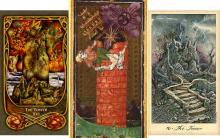Language families are a term used to classify peoples according to language. A language family includes languages that are related to each other.
It manifests itself in the similarity in the sound of words denoting the same object, as well as in the similarity of elements such as morphemes and grammatical forms.
According to the theory of monogenesis, the world's language families were formed from the proto-language spoken by ancient peoples. The division occurred due to the predominance of the nomadic lifestyle of the tribes and their distance from each other.
Language families are divided as follows.
Language family name | Languages included in the family | Regions of distribution |
Indo-European | India, Nepal, Bangladesh, Pakistan, Fiji |
|
India, Pakistan |
||
Countries of the former USSR and Eastern Europe |
||
English | USA, UK, European countries, Canada, Africa, Australia |
|
German | Germany, Austria, Liechtenstein, Switzerland, Belgium, Luxembourg, Italy |
|
French | France, Tunisia, Monaco, Canada, Algeria, Switzerland, Belgium, Luxembourg |
|
Portuguese | Portugal, Angola, Mozambique, Brazil, Macau |
|
Bengal | Bengal, India, Bangladesh |
|
Altai | Tatar | Tatarstan, Russia, Ukraine |
Mongolian | Mongolia, China |
|
Azerbaijani | Azerbaijan, Dagestan, Georgia, Iran, Iraq, Central Asia |
|
Turkish | Türkiye, Uzbekistan, Kazakhstan, Azerbaijan, Bulgaria, Romania, USA, France, Sweden |
|
Bashkir | Bashkorstan, Tatarstan, Urdmutia, Russia. |
|
Kyrgyz | Kyrgyzstan, Uzbekistan, Tajikistan, Kazakhstan, Afghanistan, China |
|
Ural | Hungarian | Hungary, Ukraine, Serbia, Romania, Slovakia, Croatia, Slovenia |
Mordovian | Mordovia, Russia, Tatarstan, Bashkorstan |
|
Evenk | Russia, China, Mongolia |
|
Finland, Sweden, Norway, Karelia |
||
Karelian | Karelia, Finland |
|
Caucasian | Georgian | Georgia, Azerbaijan, Türkiye, Iran |
Abkhazian | Abkhazia, Türkiye, Russia, Syria, Iraq |
|
Chechen | Chechnya, Ingushetia, Georgia, Dagestan |
|
Sino-Tibetan | Chinese | China, Taiwan, Singapore |
Laotian | Laos, Thailand, |
|
Siamese | ||
Tibetan | Tibet, China, India, Nepal, Bhutan, Pakistan |
|
Burmese | Myanmar (Burma) |
|
Afro-Asian | Arab | Arab countries, Iraq, Israel, Chad, Somalia, |
Barbary | Morocco, Algeria, Tunisia, Libya, Niger, Egypt, Mauritania |
From this table it is clear that languages of the same family can be distributed in a wide variety of countries and parts of the world. And the very concept of “language families” was introduced to facilitate the classification of languages and the compilation of their family tree. The most widespread and numerous is the Indo-European family of languages. Peoples speaking languages of the Indo-European family can be found in any hemisphere of the Earth, on any continent and in any country. There are also languages that are not included in any language family. These are also artificial.

If we talk about the territory of Russia, then a wide variety of language families are represented here. The country is inhabited by people of more than 150 different nationalities, who can consider almost every language family to be their native language. The linguistic families of Russia are distributed geographically depending on which country a particular region borders on, and which language is most widespread in the country bordering the region.
Some nationalities have occupied a certain territory since ancient times. And at first glance it may seem strange why these particular language families and languages predominate in this region. But there is nothing strange about this. In ancient times, human migrations were determined by the search for new hunting grounds, new lands for agriculture, and some tribes simply led a nomadic lifestyle.

The forced relocation of entire peoples during the Soviet era also played a significant role. The languages from the Indo-European, Uralic, Caucasian and Altai families are most fully represented in Russia. The Indo-European family occupies Western and Central Russia. Representatives live mainly in the north-west of the country. The northeast and southern regions are predominantly occupied by Altai language groups. Caucasian languages are represented mainly in the territory lying between the Black and Caspian seas.
Languages evolve like living organisms, and languages that descend from the same ancestor (called a "protolanguage") are part of the same language family. A language family can be divided into subfamilies, groups and subgroups: for example, Polish and Slovak belong to the same subgroup of West Slavic languages, part of the Slavic languages group, which is a branch of the larger Indo-European family.
Comparative linguistics, as its name suggests, compares languages in order to discover their historical connections. This can be done by comparing the phonetics of languages, their grammar and vocabulary, even in cases where there are no written sources of their ancestors.
The more distant languages are from each other, the more difficult it is to detect genetic connections between them. For example, no linguist doubts that Spanish and Italian are related, however, the existence of the Altaic language family (including Turkish and Mongolian) is questioned and not accepted by all linguists. At present, it is simply impossible to know whether all languages originate from a single ancestor. If a single human language existed, then it must have been spoken ten thousand years ago (if not more). This makes comparison extremely difficult or even impossible.
List of language families
Linguists have identified more than one hundred major language families (language families that are not considered related to each other). Some of them consist of only a few languages, while others consist of more than a thousand. Here are the main language families of the world.
| Language family | range | Languages |
|---|---|---|
| Indo-European | From Europe to India, modern times, by continent | More than 400 languages spoken by almost 3 billion people. These include Romance languages (Spanish, Italian, French...), Germanic (English, German, Swedish...), Baltic and Slavic languages (Russian, Polish...), Indo-Aryan languages (Persian, Hindi, Kurdish, Bengali and many other languages spoken from Turkey to Northern India), as well as others such as Greek and Armenian. |
| Sino-Tibetan | Asia | Chinese languages, Tibetan and Burmese languages |
| Niger-Congo (Niger-Kordofanian, Congo-Kordofanian) | Sub-Saharan Africa | Swahili, Yoruba, Shona, Zulu (Zulu language) |
| Afroasiatic (Afro-Asiatic, Semitic-Hamitic) | Middle East, North America | Semitic languages (Arabic, Hebrew...), Somali language (Somali) |
| Austronesian | Southeast Asia, Taiwan, Pacific, Madagascar | More than a thousand languages, including Filipino, Malagasy, Hawaiian, Fijian... |
| Ural | Central, Eastern and Northern Europe, Northern Asia | Hungarian, Finnish, Estonian, Sami languages, some Russian languages (Udmurt, Mari, Komi...) |
| Altai (disputed) | from Turkey to Siberia | Turkic languages (Turkish, Kazakh...), Mongolian languages (Mongolian...), Tungus-Manchu languages, some researchers include Japanese and Korean here |
| Dravidian | South India | Tamil, Malayalam, Kannada, Telugu |
| Thai-Kadai | Southeast Asia | Thai, Laotian |
| Austroasiatic | Southeast Asia | Vietnamese, Khmer |
| Na-Dene (Athabascan-Eyak-Tlingit) | North America | Tlingit, Navo |
| tupi (Tupian) | South America | Guarani languages (Guarani languages) |
| Caucasian (disputed) | Caucasus | Three language families. Among the Caucasian languages, the largest number of speakers is Georgian |
Special cases
Isolated languages (isolate languages)
An isolate language is an “orphan”: a language whose belonging to any known language family has not been proven. The best example is the Basque language, which is spoken in Spain and France. Even though it is surrounded by Indo-European languages, it is very different from them. Linguists have compared Basque to other languages spoken in Europe, to Caucasian languages, and even to American languages, but no connections have been found.
Korean is another well-known isolate, although some linguists suggest a connection to the Altaic languages or Japanese. Japanese itself is sometimes considered an isolate, but it is best described as belonging to the small Japanese family, which includes several related languages such as Okinawan.
Pidgin and Creole languages
A pidgin is a simplified communication system that developed between two or more groups that do not have a common language. It does not come directly from one language, it has absorbed the characteristics of several languages. When children begin to learn pidgin as a first language, it develops into a full-fledged, stable language called a creole.
Most pidgin or creole languages spoken today are the result of colonization. They are based on English, French or Portuguese. One of the most widely spoken creole languages is Tok Pisin, which is the official language of Papua New Guinea. It is based on English, but its grammar is different, its vocabulary including many loanwords from German, Malay, Portuguese and several local languages.
There are a large number of language families and a wide variety of languages in the world. There are more than 6,000 of the latter on the planet. Most of them belong to the world's largest language families, which are distinguished by their lexical and grammatical composition, related origins, and the common geographic location of their speakers. However, it should be noted that community of residence is not always an integral factor.
In turn, the world's language families are divided into groups. They are distinguished according to a similar principle. There are also languages that do not belong to any of the identified families, as well as so-called isolated languages. It is also common for scientists to distinguish macrofamilies, i.e. groups of language families.
Indo-European family
The most fully studied is the Indo-European language family. It began to be distinguished in ancient times. However, relatively recently, work began to study the Proto-Indo-European language.
The Indo-European language family consists of groups of languages whose speakers live across vast areas of Europe and Asia. So, the German group belongs to them. Its main languages are English and German. Also a large group is Romance, which includes French, Spanish, Italian and other languages. In addition, Eastern European peoples who speak languages of the Slavic group also belong to the Indo-European family. These are Belarusian, Ukrainian, Russian, etc.
This language family is not the largest in terms of the number of languages it includes. However, these languages are spoken by almost half of the world's population.
Afro-Asian family
Languages representing the Afro-Asiatic language family are spoken by more than a quarter of a million people. It includes Arabic, Egyptian, Hebrew, and many others, including extinct languages.
This family is usually divided into five (six) branches. These include the Semitic branch, the Egyptian, Chadian, Cushitic, Berber-Libyan and Omotian. In general, the Afro-Asiatic family includes more than 300 languages of the African continent and parts of Asia.
However, this family is not the only one on the continent. Other unrelated languages exist in large numbers, especially to the south, in Africa. There are at least 500 of them. Almost all of them were not presented in writing until the 20th century. and were used only orally. Some of them are purely oral to this day.
Nilo-Saharan family
The language families of Africa also include the Nilo-Saharan family. The Nilo-Saharan languages are represented by six language families. One of them is Songhai Zarma. The languages and dialects of the other family, the Saharan family, are common in Central Sudan. There is also a family of mamba, whose carriers inhabit Chad. Another family, the Fur, is also common in Sudan.
The most complex is the Shari-Nile language family. It, in turn, is divided into four branches, which consist of language groups. The last family - coma - is widespread in Ethiopia and Sudan.
The language families represented by the Nilo-Saharan macrofamily have significant differences among themselves. Accordingly, they represent great difficulty for linguistic researchers. The languages of this macrofamily were greatly influenced by the Afro-Asian macrofamily.
Sino-Tibetan family
The Sino-Tibetan language family has more than a million speakers of its languages. First of all, this became possible due to the large Chinese population speaking Chinese, which is part of one of the branches of this language family. In addition to it, this branch includes the Dungan language. It is they who form a separate branch (Chinese) in the Sino-Tibetan family.
The other branch includes more than three hundred languages, which are classified as the Tibeto-Burman branch. There are approximately 60 million native speakers of its languages.
Unlike Chinese, Burmese and Tibetan, most languages of the Sino-Tibetan family do not have a written tradition and are passed down from generation to generation exclusively orally. Despite the fact that this family has been studied deeply and for a long time, it still remains insufficiently studied and hides many as yet unrevealed secrets.

North and South American languages
Currently, as we know, the vast majority of North and South American languages belong to the Indo-European or Romance families. When settling the New World, European colonists brought their own languages with them. However, the dialects of the indigenous population of the American continent did not disappear completely. Many monks and missionaries who arrived from Europe to America recorded and systematized the languages and dialects of the local population.
Thus, the languages of the North American continent north of present-day Mexico were represented in the form of 25 language families. Later, some experts revised this division. Unfortunately, South America has not been studied as well linguistically.
Language families of Russia
All the peoples of Russia speak languages belonging to 14 language families. In total, there are 150 different languages and dialects in Russia. The basis of the country's linguistic wealth is made up of four main language families: Indo-European, North Caucasian, Altai, Uralic. Moreover, most of the country's population speaks languages belonging to the Indo-European family. This part makes up 87 percent of the total population of Russia. Moreover, the Slavic group occupies 85 percent. It includes Belarusian, Ukrainian and Russian, which make up the East Slavic group. These languages are very close to each other. Their speakers can understand each other almost without difficulty. This is especially true for the Belarusian and Russian languages.

Altaic language family
The Altai language family consists of the Turkic, Tungus-Manchu and Mongolian language groups. The difference in the number of representatives of their speakers in the country is great. For example, Mongolian is represented in Russia exclusively by Buryats and Kalmyks. But the Turkic group includes several dozen languages. These include Khakass, Chuvash, Nogai, Bashkir, Azerbaijani, Yakut and many others.
The group of Tungus-Manchu languages includes Nanai, Udege, Even and others. This group is in danger of extinction due to the preference of their native peoples to use Russian on the one hand and Chinese on the other. Despite the extensive and long-term study of the Altai language family, it is extremely difficult for specialists to decide on the reproduction of the Altai proto-language. This is explained by the large number of borrowings by its speakers from other languages due to close contact with their representatives.

Ural family
The Uralic languages are represented by two large families - Finno-Ugric and Samoyed. The first of them includes Karelians, Mari, Komi, Udmurts, Mordovians and others. The languages of the second family are spoken by the Enets, Nenets, Selkups, and Nganasans. The bearers of the Ural macrofamily are to a large extent Hungarians (more than 50 percent) and Finns (20 percent).
The name of this family comes from the name of the Ural ridge, where the formation of the Uralic proto-language is believed to have taken place. The languages of the Uralic family had some influence on their neighboring Slavic and Baltic languages. In total, there are more than twenty languages of the Uralic family both on the territory of Russia and abroad.

North Caucasian family
The languages of the peoples of the North Caucasus present a huge challenge for linguists in terms of their structuring and study. The concept of a North Caucasian family itself is rather arbitrary. The fact is that the languages of the local population are too little studied. However, thanks to the painstaking and in-depth work of many linguists studying this issue, it became clear how disjointed and complex many of the North Caucasian dialects are.
Difficulties concern not only the actual grammar, structure and rules of the language, for example, as in the Tabasaran language - one of the most complex languages on the planet, but also pronunciation, which is sometimes simply inaccessible to people who do not speak these languages.
A significant obstacle for specialists studying them is the inaccessibility of many mountainous regions of the Caucasus. However, this language family, despite all the contradictions, is usually divided into two groups - Nakh-Dagestan and Abkhaz-Adyghe.
Representatives of the first group inhabit mainly the regions of Chechnya, Dagestan and Ingushetia. These include Avars, Lezgins, Laks, Dargins, Chechens, Ingush, etc. The second group consists of representatives of related peoples - Kabardians, Circassians, Adygeis, Abkhazians, etc.

Other language families
The language families of the peoples of Russia are not always extensive, uniting many languages into one family. Many of them are very small, and some are even isolated. Such nationalities primarily live in Siberia and the Far East. Thus, the Chukchi-Kamchatka family unites the Chukchi, Itelmen, and Koryaks. Aleuts and Eskimos speak Aleut-Eskimo.

A large number of nationalities scattered across the vast territory of Russia, being extremely few in number (several thousand people or even less), have their own languages that are not included in any known language family. Like, for example, the Nivkhs, who inhabit the banks of the Amur and Sakhalin, and the Kets, located near the Yenisei.
However, the problem of linguistic extinction in the country continues to threaten Russia's cultural and linguistic diversity. Not only individual languages, but also entire language families are under threat of extinction.
There are about 3,000 languages all over the world; no one has yet been able to calculate the exact number. Although, according to available UNESCO data, there are 2,796 languages in the world. Seeing the exact figure, any linguist will smile, not because the exact number of languages in the world was counted, but from what was counted. All over the world there are many mixed languages and languages that are extinct or languages of small tribes that are not officially listed anywhere. In this regard, it is practically impossible to calculate the exact number of languages. But linguists managed to distribute all the languages of the world into groups or families.

Many different languages are similar to each other, for example, a citizen of Russia can communicate with a citizen of Belarus and Ukraine, or vice versa, and everyone will be able to understand each other. Basically, the languages of those peoples whose lands border each other or by the ethnic origin of the countries are similar. As we know, 1000 years ago, in the territory where Belarus, Ukraine and Russia are now located, there were the lands of Kievan Rus. And the ancestors of the above countries communicated in the same Old Church Slavonic language. Until our time, the borders have changed, and in place of Kievan Rus, three new states grew up: Russia, Ukraine and Belarus.
Map of the distribution of languages of Ukraine

Chinese dialect map

Indigenous languages of South America

Arabic dialects

Dialects of the Russian language

Map of African languages

German dialect map

Map of Finno-Ugric languages

Map of Slavic languages

Map of Indian languages

Families and groups of languages
Currently, linguists distinguish the following families and groups of languages:
- Indian group. This is the largest group in terms of number of speakers, as Indian languages are spoken by more than 1 billion people. This group includes the languages of Central and Northern India, as well as Pakistan. You can also include the gypsies who moved to Europe from India in the 5th - 10th centuries into this group. n. e. Of the extinct languages, this group includes the ancient Indian language - Sanskrit. The famous epic poem of ancient India, the Mahabharata, was written in this language.
- Iranian group. The languages of this group are spoken in Iran (Persian) and Afghanistan (Afghan). In this group there is a dead Scythian language.
- Slavic group. This includes a large number of different languages, which are usually further divided into subgroups.
- eastern subgroup; Russian, Ukrainian and Belarusian languages
- Western subgroup; Polish, Slovak, Czech, Kashubian, Lusatian and Polabian which is a dead language
- southern subgroup; Bulgarian, Serbo-Croatian, Slovenian, Macedonian, Old Church Slavonic or Old Church Slavonic which is also a dead language
- Baltic group. This group speaks Latvian and Lithuanian.
- German group. This group includes almost all the languages of Western Europe; Scandinavian (Norwegian, Danish, Swedish, Icelandic), English, German, Dutch and modern Jewish Yiddish. Among all the above languages in this group, English is the most widely spoken and is spoken by more than 400 million people. USA - 215 million, UK 58 million, Canada 33.5 million, Australia - 20 million, Ireland - 4 million, South Africa - 4 million, New Zealand 3.6 million. German is spoken in Germany, Austria and Switzerland. Regarding the Yiddish language, we can say that almost all Jews speak it. One of the languages of the Germanic group, Boer, is widespread in South Africa thanks to immigrants from Holland.
- Roman group. French, Romanian, Spanish, Italian, Portuguese. This group also includes Provençal, Sardinian (island of Sardinia), Catalan (Eastern Spain) and Moldavian.
- Celtic group. The languages of this group are spoken in Ireland and on the nearby islands, as well as on the Brittany peninsula of France (Breton language), in Wales (Welsh language). The dead languages of this group include the language of the ancient Gauls, who lived on the territory of modern France.
In addition to the above groups, Greek, Albanian and Armenian languages are separately distinguished, which are classified as Indo-European languages. Also included in this group are such dead languages as Hittite (Asia Minor) and Tocharian (the territory of Central Asia).











What is consolidated reporting?
Statutory audit - grounds for conducting an audit
What can you cook from chicken?
How to fry pasta in a frying pan
Instant cabbage pieces: recipes for pickling with carrots and beets